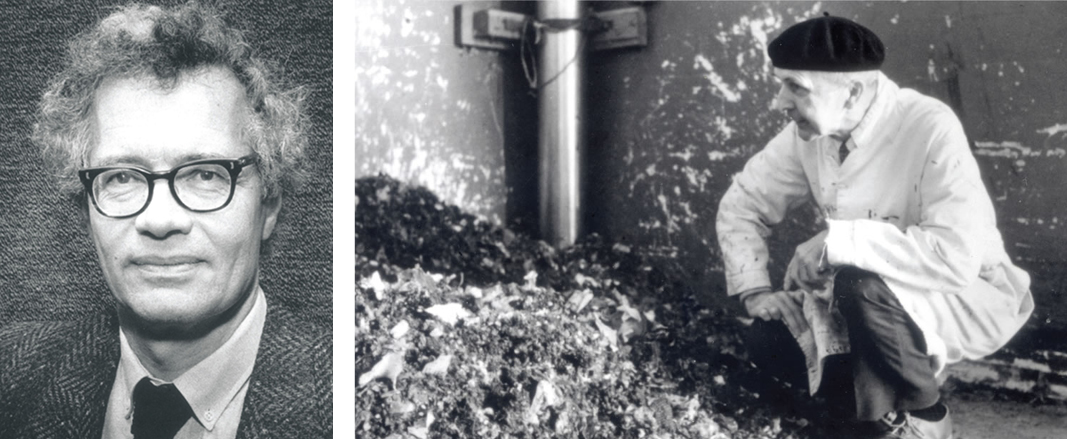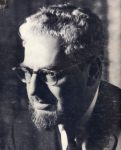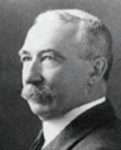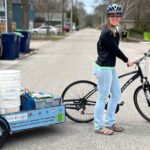Jerome Goldstein (1931 – 2012), BioCycle Founder And Clarence Golueke, PhD (1911 – 2004), University of California, Berkeley
BioCycle July 2019
Two individuals credited with blazing trails in organics recycling are Jerome (Jerry) Goldstein, founding editor of BioCycle in 1960, and Dr. Clarence Golueke of the University of California, fondly remembered as the “Grandfather of Composting.” In his new book, Lessons In Environmental Microbiology, Dr. Tim Haug (also a Trailblazer), summarizes the evolution of composting, and includes a tribute to Jerry and Clarence, which is excerpted here. The section starts with this quote by J.I. Rodale: “Compost is organic matter in its most valuable form for the earth that feeds, clothes and houses us.”
In his monumental book entitled The Complete Book of Composting, J.I. Rodale wrote in 1960, “The origin of composting has been lost, along with thousands of other age-old practices, in the dim shadows of history. When man first discovered that manure or leaf mold from the forest was good for growing plants, is a matter of speculation.”
While the knowledge of composting may be ancient, the modern era can be traced to the pioneering work of the British botanist and organic farming pioneer Sir Albert Howard (1873-1947) who is considered by many as the father of pre-World War II (WWII) composting and organic agriculture. Sir Howard spent the years 1905 to 1934 in India where he began to recognize that soil must be fertile to produce healthy plants and fertility meant a high percentage of humus. While stationed at the Indore Institute of Plant Industry, he developed a composting technique known to this day as the Indore Method. It provided a recipe and defined procedures for placing green waste, manure, and other substrates in alternating layers that would predictably heat up and not putrefy. Because of its predictable success, the Indore Method was widely adopted in the British Empire. By 1935, the tea plantations of India and Ceylon were reportedly producing one million tons of compost a year using the Indore Method.
Following WWII, there was renewed interest in finding beneficial uses for waste materials, such as refuse and municipal solid waste (MSW) and fractions derived from MSW. Beginning about 1949, the University of California at Berkeley became a major center of research under the direction of the American biologist Dr. Clarence Golueke. Dr. Golueke was a leading force in bringing science to the art of composting and is considered by many to be the father of post-WWII composting. Many of the principles of composting were developed under the direction of Dr. Golueke. Unfortunately, the industry focused most of its attention on municipal solid waste (MSW), which is a particularly difficult feedstock. Many enclosed, mechanical processes were developed and full-scale facilities built for MSW in the 1950 and 60s. These all failed for several reasons:
1) The compost product was “low” quality and always contained contaminants such as glass and plastic;
2) The need for odor control was often ignored or ineffective;
3) Landfill disposal was usually much less expensive; and
4) The environmental movement which might have rescued composting was still a decade away. This was a period dominated by entrepreneurs and some even claimed to be able to make stable compost in 24-hours, a claim with no scientific basis.
… One of the contributing authors to The Complete Book of Composting was a young man named Jerry Goldstein who saw the need for a publication that focused on larger-scale applications for composting and organics recycling. Under his direction, the journal Compost Science was launched in 1960. It was retitled to BioCycle in 1981 and remains to this day the flagship journal of the composting industry. The history of composting in the post-World War II era is chronicled in the pages of BioCycle. It has witnessed the rise and fall and rise again of refuse composting, the emergence and rapid advance of municipal sludge composting, the explosion in leaf and yard waste composting, and the many problems and solutions developed over time. The interested reader can further explore the modern history and science of composting in the pages of BioCycle.
— Dr. R. Tim Haug, Lessons In Environmental Biology, CRC Press (August 2019)
Continue reading
















